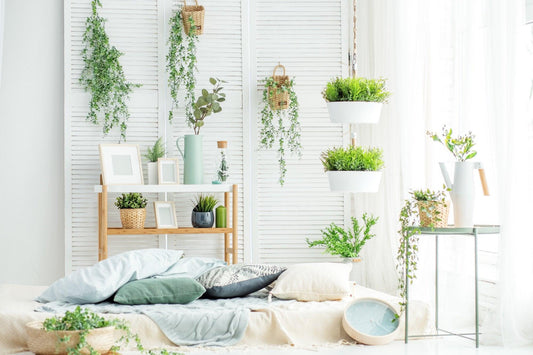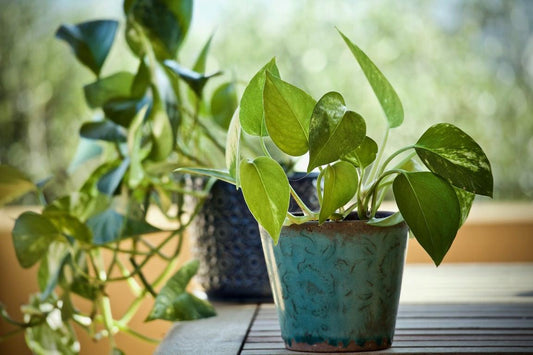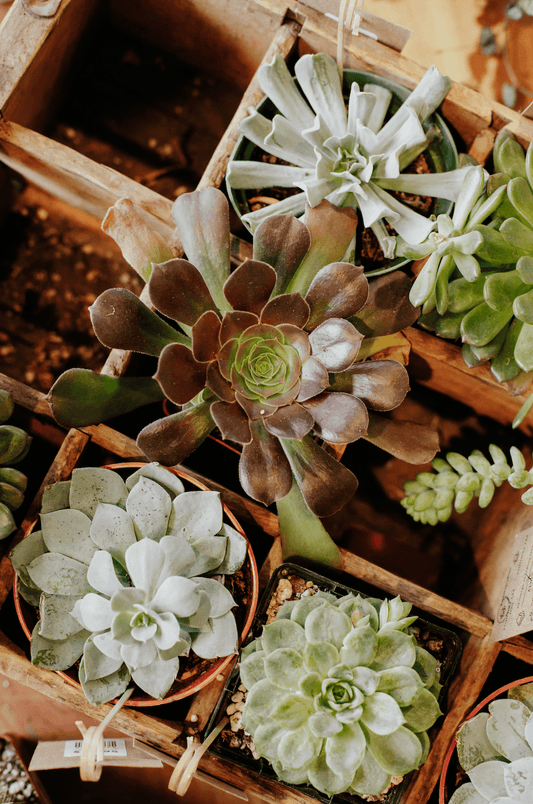Jade
How to Care for the Jade Plant
Overview
Jade plants, also referred to as lucky plants, are a very popular type of houseplant. Jades are a part of the Crassula family, which includes some of the most incredibly diverse, adaptable, and well-known succulents.
Jade plants can grow like bonsai trees and can be pruned similarly, too! As the plant ages, the stem begins to resemble a tree trunk, thick and bark-like. Jades have egg-shaped leaves that are fleshy, shiny, and dark green in color. When given enough sunlight, the edges of the leaves will turn pinkish-red with sun stress, which is not a negative type of stress.


Profile
Jades are thought to bring their owners good luck and fortune. While this plant has the ability to bloom, it is very unlikely that it will in an indoor setting. Jade plants are toxic to both humans and pets, so please don’t eat them! missmarienjose@gmail.com why are they toxic? What will happen if I eat it?




Low light
Remember that succulents are desert plants, and deserts don’t get a lot of regular rainfall. Jade plants, like most succulents, have thick, meaty leaves in order to retain water. Too frequent watering will cause rot from extensive moisture retention. Only water when the soil is 100% dry, and then some. At this point, you can thoroughly water your Jade until the water starts coming out the drainage hole. An important reminder to remember is that succulents don’t like their leaves getting wet, as they can get mushy and soft.

Occasional
You’ll have to check the soil for moisture rather than keeping Jade on a watering schedule; soil moisture can change depending on the type of pot it is in (terracotta, ceramic, plastic, etc.), how big the pot is, and what time of the year it is. For example, you might only have to water your Jade once every two months in the winter, but the soil dries up much faster in summer heat and sun.

Easy breezy
Keeping in mind that succulents are desert plants, Jades will take as much sun as you can possibly give them. This is why jade plants can live outdoors during the summer, either in a pot or the ground if warm enough. When indoors, Jades love to live on a very bright window sill or under an artificial light designed to give full-sun plants more light. If it is not getting enough sun, your succulent will become etoliated, meaning it will reach for the light while growing, creating a plant that is leggy, and more stem than foliage. Considering many people own jade plants for the purpose of it growing into a bushy, shrub-like plant, it’s best to do everything you can to get those leaves to grow close together! Once etiolation happens, your plant won’t go back to its smaller, compacted size without a big pruning.
Giving emphasis to what we have said earlier, we'd like to give you the important tip that succulents abide by the rule of "less is more." Ignore them more often, and they will thank you for it!
FREQUENTLY ASKED QUESTIONS (FAQs)
on Jade
How do you propagate a jade plant?
Jade plants are succulents, so they can be propagated the same way other succulents are propagated. Check out the FAQ section in our succulent profile for how to propagate a succulent!
If you would rather not wait as long for a new plant from a leaf, you can take a cutting from one of your Jade’s bigger stems. If you decide to go this route, make sure that the parent plant will still look just as beautiful after you cut your section off. After you have your cutting, allow the end of the stem to callus over before potting it in cactus soil for the best chance at root development.
How do you prune a jade plant?
If you want to just prune the leaves, you can carefully pick off the leaves you no longer want on your plant with your fingers. Make sure that the leaf is fulling coming off of the stem for a clean look and no leaf bits are left behind.
If you are wanting to prune stems off of your jade, it is best to use a sharp, clean pair of gardening shears or scissors. Sometimes, if a stem is really dead or unhealthy, it’ll fall off right into your hand. For healthier, stronger stems, prune regularly to encourage new growth.
Once you’ve pruned it the way you like, you can dispose of, or propagate the cuttings you took. The original plant will eventually grow a callus over the places that were cut.
How do you grow a jade plant into a tree?
Since jade plants aren’t actually trees, you’re going to have to create an optical illusion. It’s all about the pruning! This effect works best with larger, mature jade plants—you’ll be waiting for a tree for a long time if you try to start with a smaller-sized jade. There are many decorative, tree-like styles that people manipulate their jade plant to look like, so find one that best fits your home’s personality!
Locate the main trunk of your Jade. This main trunk is very important to the look of your Jade bonsai. Prune off any leaves or branches that are towards the bottom of your jade plant so that the trunk is long and prominent. Leave the top of your jade full and bushy in order to create the classic tree look. Some people will follow certain strong branches to create more unique tree shapes.
Remember that if you made a happy accident or no longer like your tree shape, your Jade will eventually grow back full, allowing you to try again!
Why is my jade plant losing leaves?
Jade plants are a little dramatic. They’ll lose a leaf or two over anything, especially if they go a long time without the proper care conditions. Your Jade could be losing leaves from too much watering, not enough watering, not enough sun, a pest infestation, getting bumped into, and more. You’re going to need to look for context clues to diagnose why your Jade is losing leaves. Is your plant otherwise healthy? How do the leaves look? Is it in its preferred care conditions? Do you see anything crawling around on the leaves? These are some questions you should ask yourself to get to the bottom of this case.
Why is my jade plant drooping?
Like many plants, Jades can droop from both over- and underwatering. Overwatering will affect the whole plant, including leaves, stems, and roots. This creates a very unstable, mushy plant. Drooping due to underwatering usually affects the leaves the most, though the stems might look a little shrivelled, too. Check the soil conditions of your jade plant to figure out the next course of action. If the soil is bone dry, give your plant a drink; if it is really moist, it might be best to repot your jade into fresh, dry soil.
Why are my jade’s leaves crystalizing?
Like many of Jade’s issues, crystalization is due to watering. For this particular issue, the cause is underwatering. When a jade plant has been dry for a long time, the leaves will dry up too, leaving hard, shriveled crystallized leaves. This crystalization looks a little white and shimmery against a dark, dead leaf. You can pick off these leaves and give your Jade a thorough watering in order to fix the issue.




